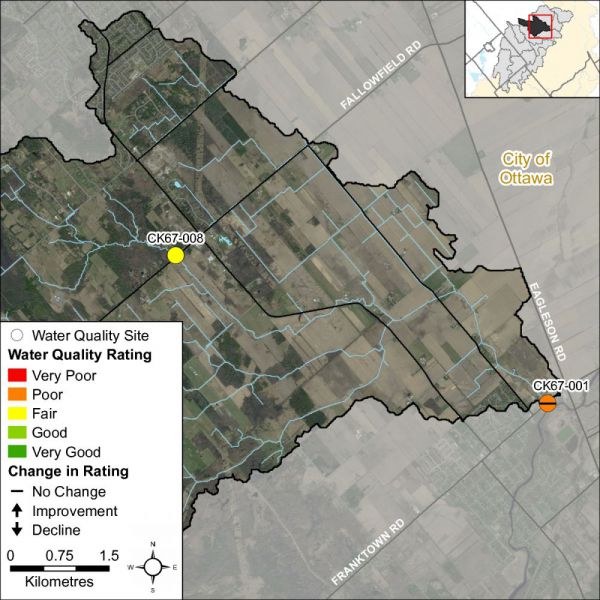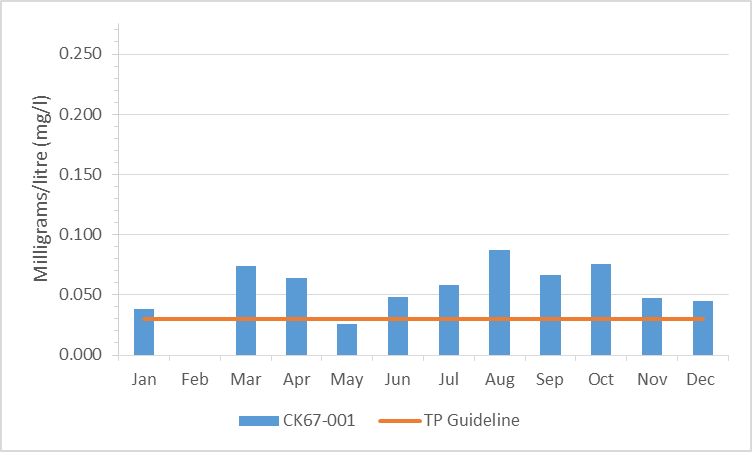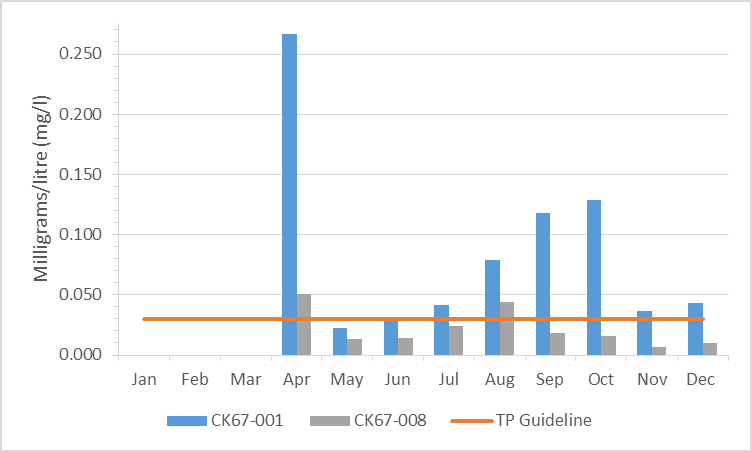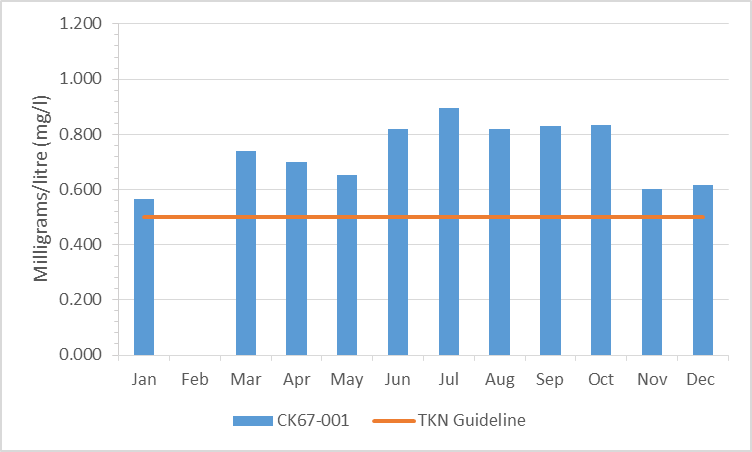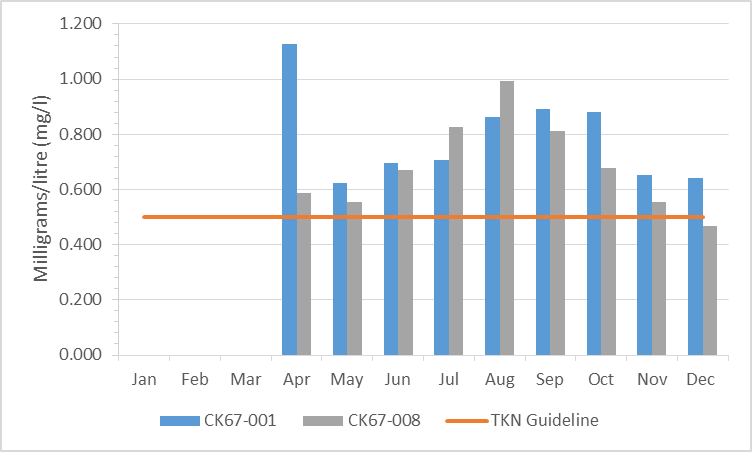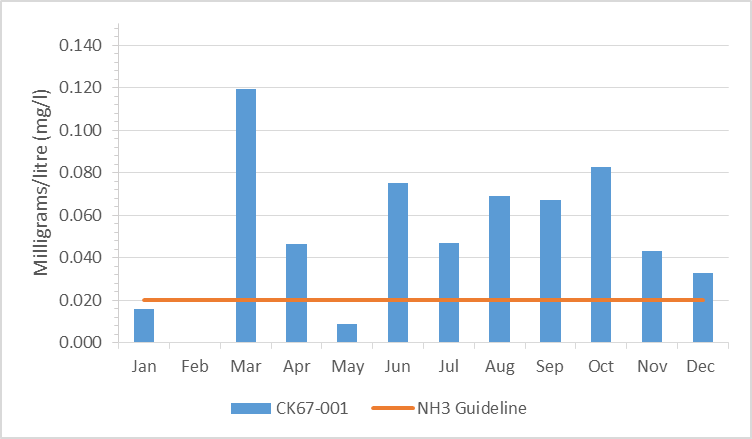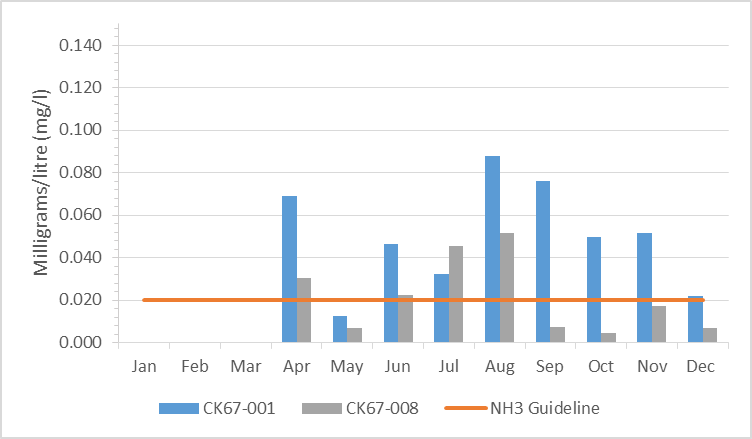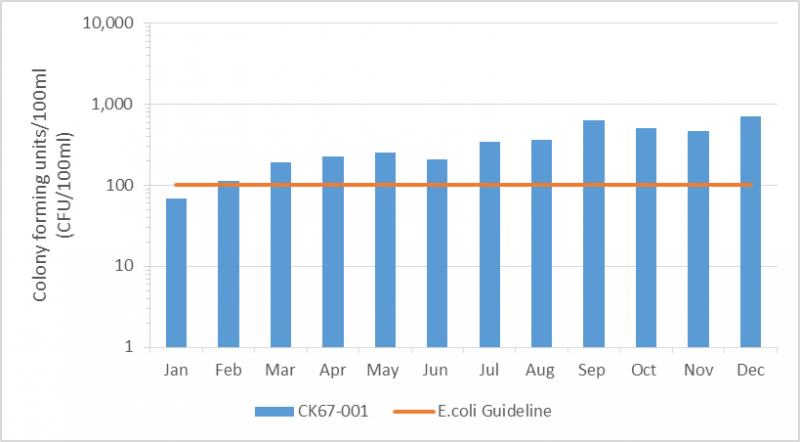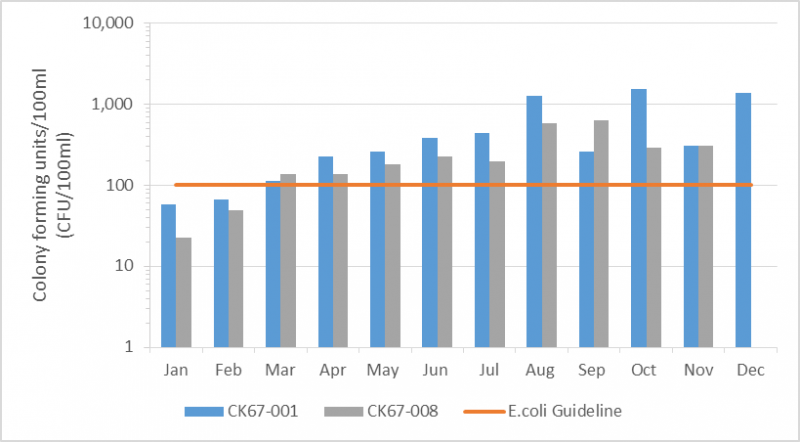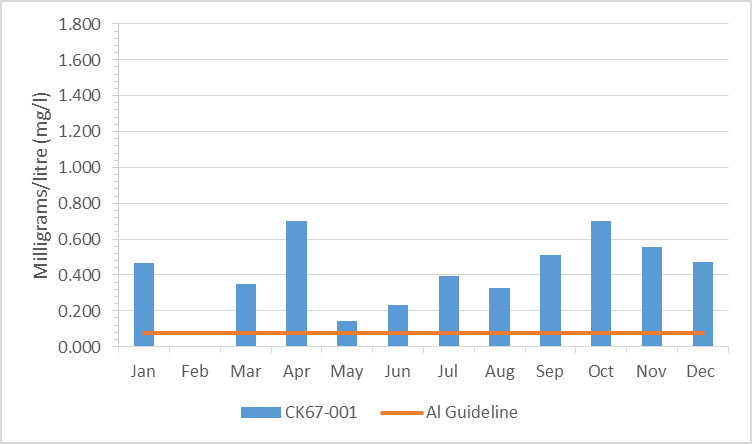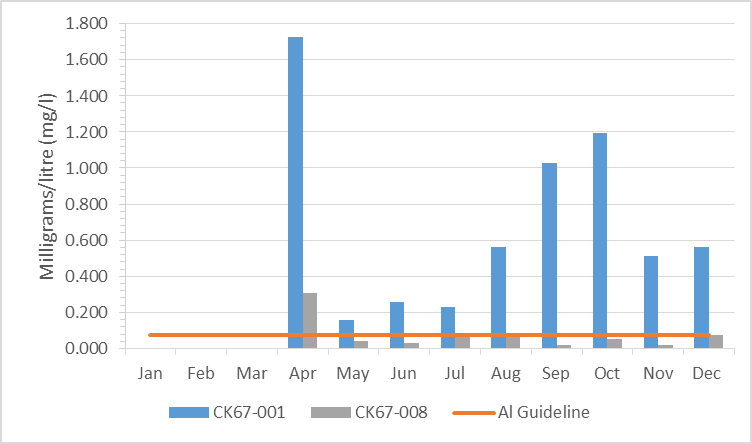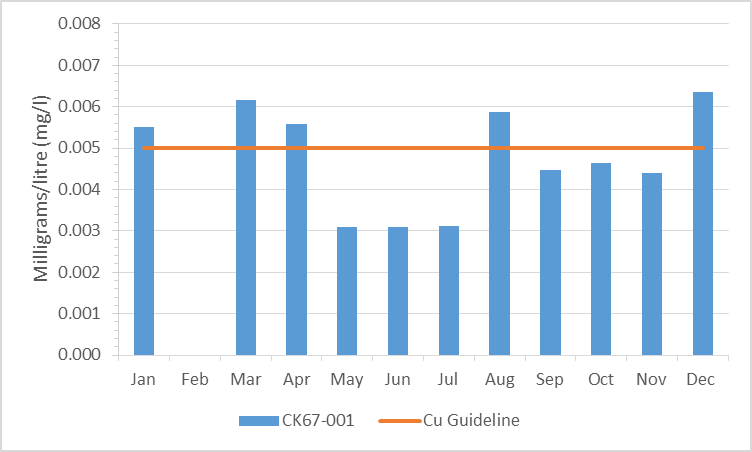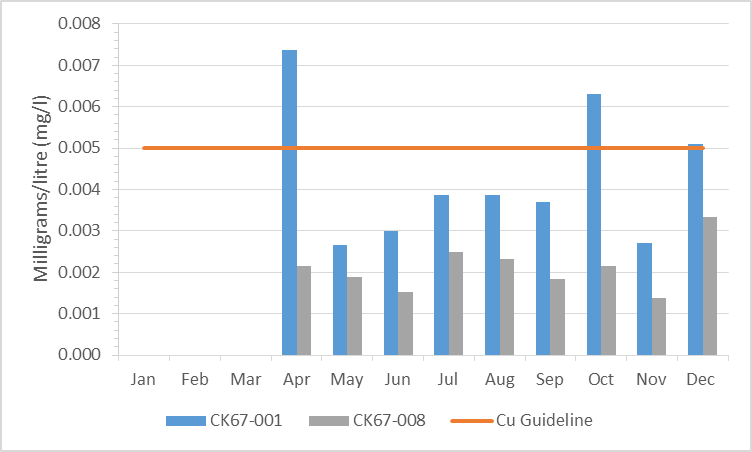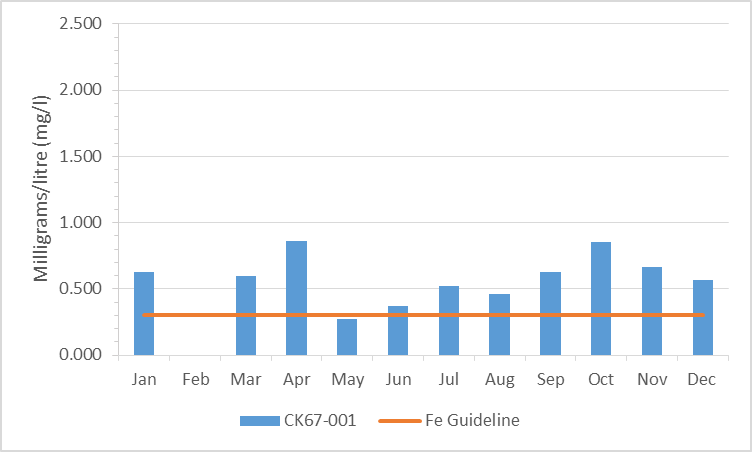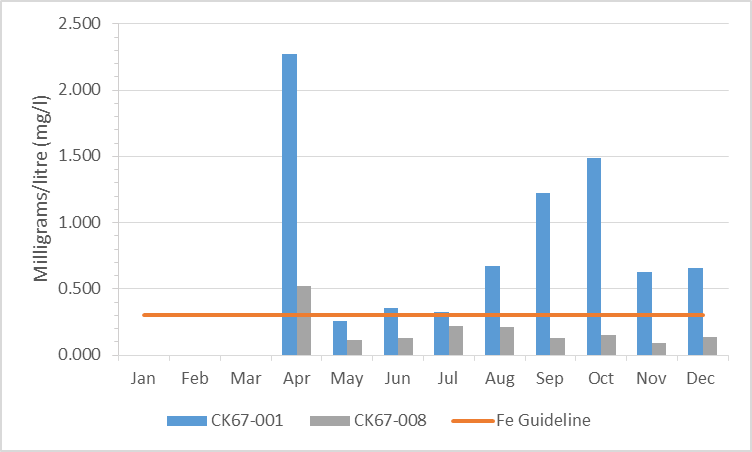2.0 Flowing Creek Catchment: Surface Water Quality Conditions
Surface water quality conditions in the Flowing Creek catchment are monitored by the City of Ottawa Baseline Water Quality Monitoring Program. This program provides information on the condition of Ottawa’s surface water resources; data is collected for multiple parameters including nutrients (total phosphorus, total Kjeldahl nitrogen and ammonia), E. coli, metals (like aluminum and copper) and additional chemical/physical parameters (such as alkalinity, chlorides, pH and total suspended solids). The locations of monitoring sites are shown in Figure 2 and Table 1.
2.1 Flowing Creek Water Quality Rating
The RVCA's water quality rating for monitored sites on Flowing Creek (CK67-001 and CK67-008) range from “Poor” to “Fair” (Table 1) as determined by the Canadian Council of Ministers of the Environment (CCME) Water Quality Index (WQI)[1]. A “Fair” rating indicates that water quality is usually protected but is occasionally threatened or impaired; conditions sometimes depart from natural or desirable levels. A “Poor” rating indicates that water quality is frequently threatened or impaired; conditions often depart from natural or desirable levels. Parameters are evaluated against established guidelines to determine water quality conditions. Those parameters that frequently exceed guidelines are presented below. Analysis of the data has been broken into two periods; 2004 to 2009 and 2010 to 2015 to examine if conditions have changed between these periods. Table 1 shows the overall rating for the monitored surface water quality sites within the Flowing Creek catchment and Table 2 outlines the Water Quality Index (WQI) scores and their corresponding ratings.
Between the 2004-2009 and 2010-2015 time frames the water quality score at site CK67-001 has declined, but has retained a rating of POOR across both periods (Table 1). There is no data available for the 2004-2009 period at site CK67-008, in the 2010-2015 period the rating was determined to be FAIR with a WQI score of 74. The scores at these sites are largely influenced by frequent high nutrient concentrations. For more information on the CCME WQI, please see the Jock River Subwatershed Report.
| Sampling Site | Location | 2004-2009 | Rating |
|---|---|---|---|
| CK67-001 | Flowing Creek upstream of Perth St bridge between Shea Rd and Eagleson Rd. | 61 | Poor |
| CK67-008 | Flowing Creek downstream of Fallowfield Rd bridge-culvert, south west of Huntley Rd. | NA | NA |
| Sampling Site | Location | 2010-2015 | Rating |
| CK67-001 | Flowing Creek upstream of Perth St bridge between Shea Rd and Eagleson Rd. | 48 | Poor |
| CK67-008 | Flowing Creek downstream of Fallowfield Rd bridge-culvert, south west of Huntley Rd. | 74 | Fair |
| Rating | Index Score |
|---|---|
| Very Good (Excellent) | 95-100 |
| Good | 80-94 |
| Fair | 65-79 |
| Poor (Marginal) | 45-64 |
| Very Poor (Poor) | 0-44 |
2.2 Nutrients
Total phosphorus (TP) is used as a primary indicator of excessive nutrient loading and may contribute to abundant aquatic vegetation growth and depleted dissolved oxygen levels. The Provincial Water Quality Objective (PWQO) is used as the TP Guideline and states that in streams concentrations greater than 0.030 mg/l indicate an excessive amount of TP.
Total Kjeldahl nitrogen (TKN) and ammonia (NH3) are used as secondary indicators of nutrient loading. RVCA uses a guideline of 0.500 mg/l to assess TKN[2] and the PWQO of 0.020 mg/l to assess NH3 concentrations in the Jock River.
Tables 3, 4 and 5 summarize average nutrient concentrations at monitored sites within the Flowing Creek catchment and show the proportion of results that meet the guidelines.
| Total Phosphorus 2004-2009 | |||
|---|---|---|---|
| Site | Average (mg/l) | Below Guideline | No. Samples |
| CK67-001 | 0.057 | 11% | 53 |
| CK67-008 | NA | NA | NA |
| Total Phosphorus 2010-2015 | |||
| Site | Average (mg/l) | Below Guideline | No. Samples |
| CK67-001 | 0.082 | 27% | 49 |
| CK67-008 | 0.021 | 84% | 44 |
| Total Kjeldahl Nitrogen 2004-2009 | |||
|---|---|---|---|
| Site | Average (mg/l) | Below Guideline | No. Samples |
| CK67-001 | 0.746 | 17% | 53 |
| CK67-008 | NA | NA | NA |
| Total Kjeldahl Nitrogen 2010-2015 | |||
| Site | Average (mg/l) | Below Guideline | No. Samples |
| CK67-001 | 0.785 | 2% | 49 |
| CK67-008 | 0.685 | 16% | 44 |
| Ammonia 2004-2009 | |||
|---|---|---|---|
| Site | Average (mg/l) | Below Guideline | No. Samples |
| CK67-001 | 0.054 | 37% | 52 |
| CK67-008 | NA | NA | NA |
| Ammonia 2010-2015 | |||
| Site | Average (mg/l) | Below Guideline | No. Samples |
| CK67-001 | 0.050 | 22% | 49 |
| CK67-008 | 0.022 | 75% | 44 |
Monitoring Site CK67-001
The majority of samples at site CK67-001 were above the TP guideline in both the 2004-2009 and 2010-2015 periods (Figures 3, and 4) . The number of sample results below the TP guideline improved slightly from 11 percent in 2004-2009 to 27 percent in 2010-2015 (Table 3). Though more samples were below the guideline the average TP concentrations increased from 0.057 mg/l (2003–2008) to 0.082 mg/l (2009–2014).
TKN concentrations show that the bulk of results exceeded the guideline (Figures 5 and 6); 17 percent of samples were below the guideline in the 2004-2009 period, this declined to only two percent in the 2010-2015 period. The average concentration was elevated and increased from 0.746 mg/l to 0.785 mg/l (Table 4).
In the 2004-2009 reporting period 37% of NH3 results were below the guideline with an average concentration of 0.054 mg/l (Figure 7, Table 5). The percentage of results below the guideline declined to 22% in the 2010-2015 period, the average concentrations declined slightly to 0.050 mg/l (Figure 8, Table 5).
Monitoring Site CK67-008
TP results were typically below the guideline at site CK67-008; 84 percent of samples were below the guideline in the 2010-2015 period (Figure 4). The average TP concentration during this same time frame was 0.021 mg/l (Table 3).
The bulk of TKN results have exceeded the guideline (Figure 6), with 16 percent of samples below the guideline in the 2010-2015 period. The average concentration was elevated at 0.685 mg/l (Table 3).
The results for NH3 indicate that occasional exceedances occurred. Seventy-five percent of results were below the guideline in the 2010-2015 reporting period (Figure 8). The average NH3 concentration was just above the guideline at 0.022 mg/l (Table 5).
Summary
Nutrient enrichment is a feature of Flowing Creek. Most nutrient parameters (total phosphorus, total Kjeldahl nitrogen and ammonia) are above guidelines at each site, apart from TP concentrations in the upstream site (CK67-008). Elevated nutrients may result in nutrient loading downstream and to the Jock River. High nutrient concentrations stimulate the growth of algae blooms and aquatic vegetation in a waterbody, and deplete oxygen levels as the vegetation dies off and decompose. Average concentrations for TP and TKN are particularly high in April, likely due to spring time runoff conditions. Increased nutrients concentrations also appear to be an issue in the late summer and early fall. Best management practices such as improved storms water management, enhanced shoreline buffers, preventing the use of fertilizers and restricting livestock access in agricultural areas can help to reduce nutrient enrichment.
2.3 Escherichia coli
E. coli is used as an indicator of bacterial pollution from human or animal waste; in elevated concentrations it can pose a risk to human health. The PWQO of 100 colony forming units/100 millilitres (CFU/100 ml) is used. E. coli counts greater than this guideline indicate that bacterial contamination may be a problem within a waterbody.
Table 6 summarizes the geometric mean[3] for the monitored sites within the Flowing Creek catchment and shows the proportion of samples that meet the E. coli guideline of 100 CFU/100 ml. The results of the geometric mean with respect to the guideline for the two periods, 2004-2009 and 2010-2015, are shown in Figures 9 and 10 respectively.
| E. coli 2004-2009 | |||
|---|---|---|---|
| Site | Geometric Mean (CFU/100ml) | Below Guideline | No. Samples |
| CK67-001 | 221 | 25% | 53 |
| CK67-008 | NA | NA | NA |
| E. coli 2010-2015 | |||
| Site | Geometric Mean (CFU/100ml) | Below Guideline | No. Samples |
| CK67-001 | 262 | 27% | 49 |
| CK67-008 | 99 | 43% | 44 |
Monitoring Site CK67-001
E. coli counts at site CK67-001 indicate little change with regard to bacterial contamination (Figures 9 and 10). The proportion of samples below the guideline rose marginally from 25 percent to 27 percent. The count at the geometric mean increased from 221 CFU/100ml in 2004-2009 to 262 CFU/100ml in 2010-2015 (Table 6).
Monitoring Site CK67-008
Elevated E. coli counts at site CK67-008 occurred regularly at this site (Figure 10). Forty-three percent of samples were below the guideline in the 2010-2015 period, and the count at the geometric mean was just below the PWQO at 99 CFU/100ml (Table 6).
Summary
Bacterial contamination appears to be a significant concern in Flowing Creek; at both sites (CK67-001 and CK67-008) regular exceedances occur andthe geometric mean exceeds or is just below the guideline of 100 CFU/100ml. Best management practices such as enhancing shoreline buffers and limiting livestock access should be employed wherever possible to help to improve water quality conditions on Flowing Creek and its impact on the Jock River.
2.4 Metals
Of the metals routinely monitored in Flowing Creek, aluminum (Al), copper (Cu) and iron (Fe) reported concentrations above their respective PWQOs, particularly at the downstream site (CK67-001). In elevated concentrations, these metals can have toxic effects on sensitive aquatic species. The PWQO for Al is 0.075 mg/l, for Cu it is 0.005 mg/l and Fe is 0.300 mg/l.
Tables 7, 8 and 9 summarize metal concentrations at sites CK67-001 and CK67-008, as well as show the proportion of samples that meet guidelines. Figures 11 to 16 show metal concentrations with respect to the guidelines for the two periods of interest, 2004-2009 and 2010-2015.
| Aluminum 2004-2009 | |||
|---|---|---|---|
| Site | Average (mg/l) | Below Guideline | No. Samples |
| CK67-001 | 0.443 | 2% | 53 |
| CK67-008 | NA | NA | NA |
| Aluminum 2010-2015 | |||
| Site | Average (mg/l) | Below Guideline | No. Samples |
| CK67-001 | 0.664 | 0% | 48 |
| CK67-008 | 0.071 | 77% | 43 |
| Copper 2004-2009 | |||
|---|---|---|---|
| Site | Average (mg/l) | Below Guideline | No. Samples |
| CK67-001 | 0.0045 | 70% | 53 |
| CK67-008 | NA | NA | NA |
| Copper 2010-2015 | |||
| Site | Average (mg/l) | Below Guideline | No. Samples |
| CK67-001 | 0.0041 | 71% | 48 |
| CK67-008 | 0.0020 | 88% | 43 |
| Iron 2004-2009 | |||
|---|---|---|---|
| Site | Average (mg/l) | Below Guideline | No. Samples |
| CK67-001 | 0.579 | 25% | 53 |
| CK67-008 | NA | NA | NA |
| Iron 2010-2015 | |||
| Site | Average (mg/l) | Below Guideline | No. Samples |
| CK67-001 | 0.845 | 25% | 48 |
| CK67-008 | 0.180 | 88% | 43 |
Monitoring Site CK67-001
The Al concentrations at site CK67-001 far exceeded the guideline. Only two percent of samples were below the guideline from 2004-2009 (Figure 11), this declined to no results reporting below the guideline from 2010-2015 (Figure 12). The average concentration increased from 0.443 mg/l to 0.664 mg/l (Table 7).
Copper concentrations occasionally exceeded the PWQO, with 70 percent of samples below the guideline in 2004-2009 (Figure 13). The Cu concentrations were consistent into the 2010-2015 period, with 71 percent of samples below the guideline in 2010-2015 (Figure 14). The average concentration of copper marginally decreased during the two reporting periods from 0.005 mg/l to 0.004 mg/l (Table 8).
Results from CK67-001 indicated that Fe concentrations exceeded the guideline. The proportion of samples below the guideline was unchanged at 25 percent between the two reporting periods (Figures 15 and 16). During the 2004-2009 reporting period average Fe concentrations were above the guideline with a concentration of 0.579 mg/l this increased to 0.845 mg/l in the 2010-2015 period (Table 9).
Monitoring Site CK67-008
Results from CK67-008 are only available for the 2010-2015 period. Results show that Al concentrations often meet the objective with 77 percent of samples below the guideline (Figure 11). The average concentration of Al was below the guideline at 0.071 mg/l (Table 7).
Copper concentrations have occasionally exceeded the guideline. In the 2010-2015 period 88 percent of samples were below the guideline (Figure 14). The average concentration was below the guideline at 0.0020 mg/l (Table 8).
The majority of Fe results were below the guideline; 88 percent of samples were below the guideline in the 2010-2015 period (Figure 16). The average concentration was below the guideline in the 2010-2015 reporting period with a concentration of 0.180 mg/l (Table 9).
Summary
Concentrations of both iron and aluminum have increased within this catchment, and average concentrations exceed the guideline at site CK67-001. There has been increased development directly upstream of this site and it is possible that these increases may be due to increased runoff from surfaces and traffic. Efforts should continue to be made to identify pollution sources and implement best management practices in both the urbanized and rural areas to reduce any inputs such as storm water runoff, metal alloys, fungicides and pesticides to improve overall stream health and lessen downstream impacts.
1 The City of Ottawa Baseline Water Quality Monitoring Program has also applied the CCME WQI to monitored sites. The parameters used and time periods differs between the RVCA and City of Ottawa’s application of the WQI, resulting in different ratings at some sites.
2 No Ontario guideline for TKN is presently available; however, waters not influenced by excessive organic inputs typically range from 0.100 to 0.500 mg/l, Environment Canada (1979) Water Quality Sourcebook, A Guide to Water Quality Parameters, Inland Waters Directorate, Water Quality Branch, Ottawa, Canada
3 A type of mean or average, which indicates the central tendency or typical value of a set of numbers by using the product of their values (as opposed to the arithmetic mean which uses their sum). It is often used to summarize a variable that varies over several orders of magnitude, such as E. coli counts
